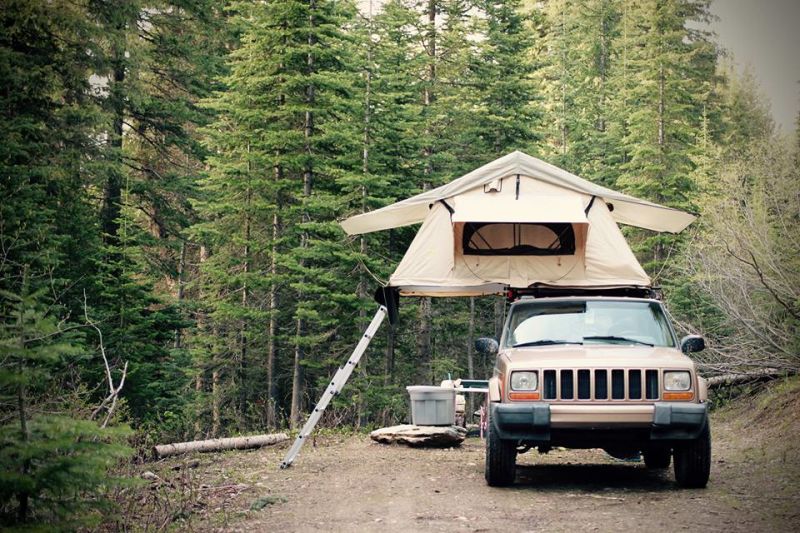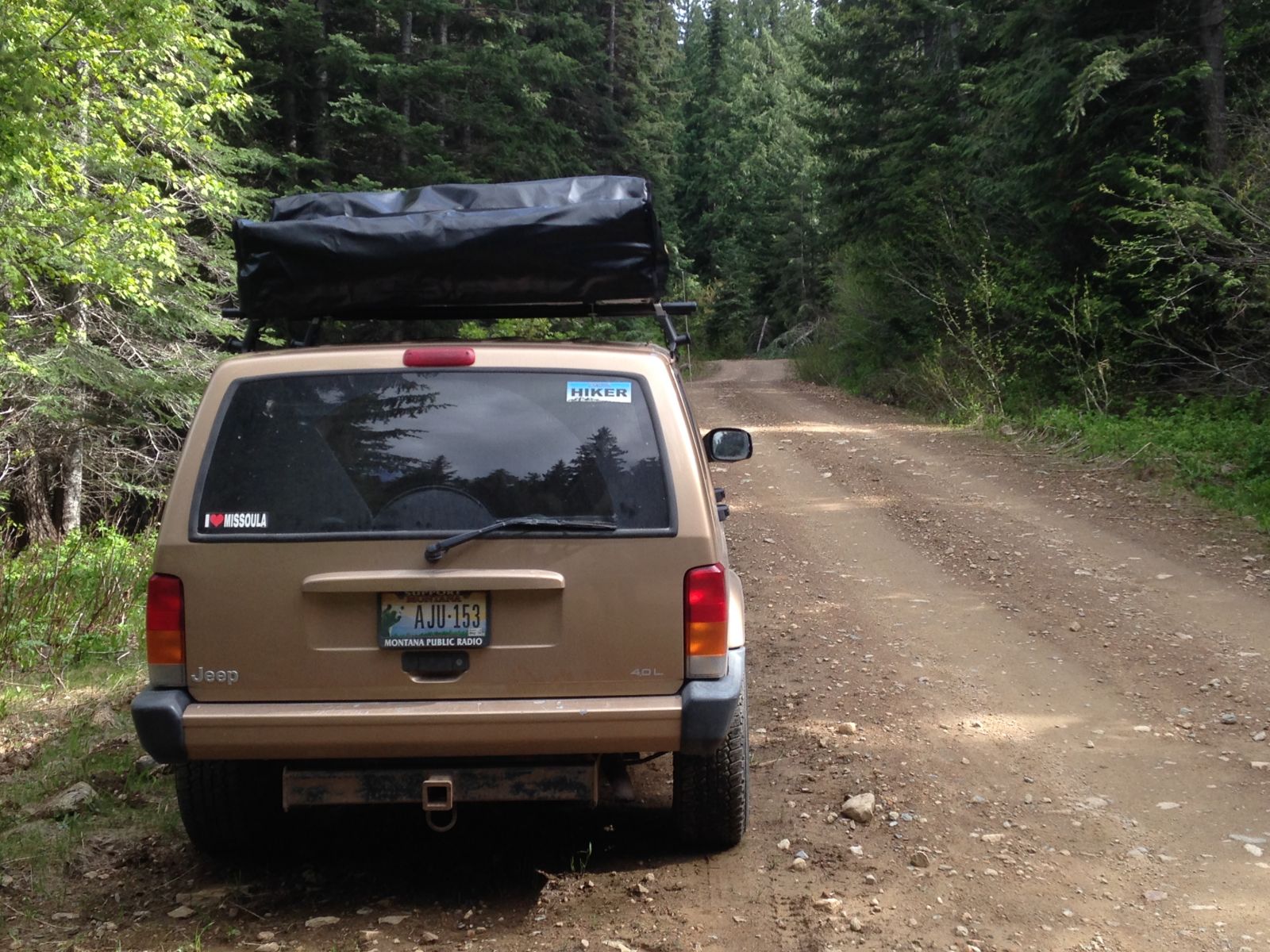
A couple of weeks ago the UPS man (men?) dropped off a 120 lb. box at our front door with a Smittybilt Overlander roof top tent in it. After using a RTT in southern Africa for three weeks last year, we were pretty convinced that sleeping high on the hog was the life for us.
We had a chance over the last two weekends to try it out for very short trips within about 50 miles of home (hooray for Montana, public lands, and the American west in general, for easily-accessed wilderness solitude).
I’m going to withhold final judgments until we have more time with the thing, but here are a few first impressions.
- Soft-side RTT design hasn’t really evolved much in the last 70 years or so. The Overlander is a relatively new product, but it’s essentially a copy of the ARB tent, which is a copy of the Howling Moon tent that was bolted to our HiLux in Africa last year, which is basically a copy of the Eezi-Awn, which, well, is the same as all the others. Many of them are even built at the same factories in China.
- Smittybilt positions itself in the market as a purveyor of reasonably priced off-road equipment (some might call it “cheap”), and the Overlander RTT is no exception. It shipped free to us in four days (usually a $150 - $200 charge), and was at least $50 less expensive than comparable tents. We paid $829.00 out-the-door with a coupon. At that price point, why not give it a try?
- What did it come with? Besides the tent itself and the associated mounting hardware, additional features include: an eye-searing LED light strip with Velcro attachments for the inside (really, it’s too bright), an extra-long cord to plug it into the power point in the car, as well as adapters with USB ports for charging phones, etc., a rugged and waterproof (with drain holes) shoe bag for hanging muddy footwear outside the tent, slightly vague installation instructions, and a rubberized travel cover. The whole thing weighs 118 lbs.
- Installation was a snap and took about 2 hours- bolting the aluminum structural rails to the bottom is the most detailed work, but with a helper it’s not difficult. 1-2-3, up! - onto the roof rack, and then getting the thing centered is the last step. A ratcheting box-end wrench for the mounting brackets smooths the way on this step.
- I’m using two old-school round Yakima crossbars with gutter-mount (not Guttermouth) towers to support it. I’m a little nervous about weight distribution with this set-up (how strong are those drip rails, really?). I acquired a third bar and towers this week, so that will make me feel a little bit better.
- How about set-up? With very little practice, we can already get the Overlander ready for sleepy-time in about seven minutes - rip the travel cover, lever the ladder, unfold, and hit the hay. The one fiddly part of set-up are the damn flysheet poles.
This was a problem we encountered with our Howling Moon tent in Africa, too - the flysheets that create little roofs over the side windows and doors are suspended by steel polls that need to be inserted into grommets in the fly, and then bent and coaxed into pre-drilled holes in the aluminum frame that creates the base of the tent. I’m not sure if the holes are not drilled out wide enough, or at a bad angle, or if it’s that steel and aluminum don’t mix well, but this process has us cursing. I will be pondering a solution for this. - When you’re ready to leave, what about take-down? This process is a little more involved, but still pretty straightforward. Struggle to remove the flysheet poles, then, using the ladder, fold the tent onto itself, tuck stray fabric into the folds, cinch the Velcro straps to tighten everything up, and sling the rubberized travel cover on top. I did it in 11 minutes by myself this weekend.
- About that travel cover? One of the major complaints we had about the Howling Moon tent last summer was the attachment of the cover. It was made of canvas and permanently bonded to the tent structure with a badly aligned zipper.
This resulted in two outcomes: (1) when we took it off, it draped over the side of the vehicle obstructing access to the doors, and (2) the poor alignment of the zipper made it a bear to install in the mornings, especially when it was cold and stiff.
The Smittybilt cover is much, much better - the rubberized material stretches well, and the wide Velcro strips that are used to secure it to the tent on all sides are very strong. When the cover is removed it separates completely from the tent structure, so you just fold it up and stash it between the truck roof and the tent bottom. It also has expandable corners with Velcro closures, so even on cool mornings you can stretch it over the ends of the tent with no hassle. - How does it sleep? Well, the first weekend we escaped for two nights, and we found the mattress, while supportive, terribly stiff. This was a repeat of the Howling Moon tent’s mattress situation, so perhaps that’s an industry standard. A memory foam mattress topper from Wal-Mart totally solved this problem for our trip the week after.
Size-wise, the mattress is between a Queen and a Full, which is great, because my wife sleeps like she’s a starfish - all limbs extended fully in every direction.
It has plenty of headroom, and the bedding - one foam mattress topper, one down comforter, and a sheet, in our case - can be folded easily into the tent every day. - Build quality seems top notch - the hardware and rivets are robust, all of the seams are sealed perfectly, and everything works as advertised. There are no stray threads or misaligned zippers. The sunroof panels are a serious bonus, and you can see the stars pretty clearly through the mesh netting. Ventilation - a major issue for me (GIVE ME ALL THE FRESH AIR) - is excellent.
- Concerns and quibbles? I am a little nervous about the Velcro on some of the tie-down straps for the tent structure. After only a half dozen openings and closings, the fuzzy side seems to be pilling already - this reduces the gripping power,and since they hold the thing together that’s a concern. They are only bonded in the frame with screws, so I can see maybe replacing them with a more robust D-ring system down the line.
Overall we’re pretty darn happy with our purchase. One of the intangibles is simply the motivation to get out there - with the tent ready to go on top of the Jeep, and the rest of the camping supplies packed in bins in the back, it’s really easy to just jump in the car and hit the road at the drop of a hat.
My wife says that sleeping up high also has a positive psychological effect - she’s not nearly concerned about the bear situation as she is with a ground tent. We saw two black bears on our most recent trip to the Bitterroot mountains last weekend. This results in more restful sleep - something Andrew SP White has discussed in the past. Don’t underestimate the benefits of a good night’s sleep.
We’re taking the Jeep on a long trip next week to Utah for some backpacking, so I’ll be curious about the effects on fuel consumption.
As we use it more, I’ll keep reporting on our experiences with the Overlander.
